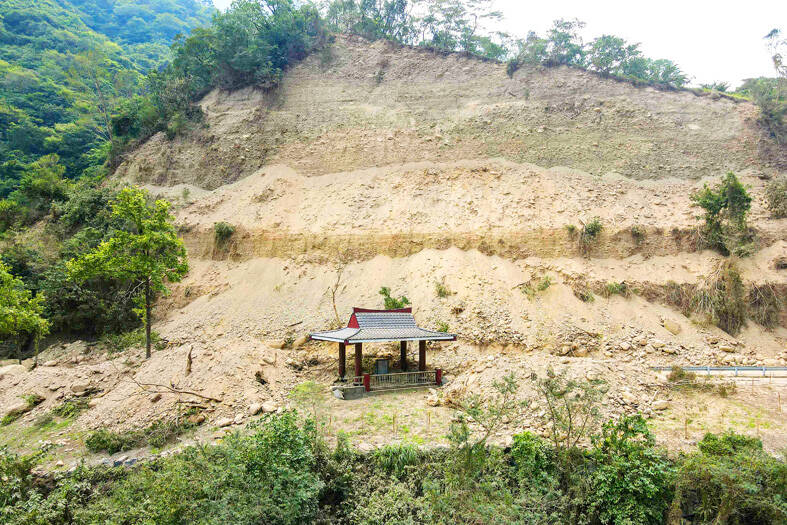It would cost about NT$1 billion (US$30.89 million) to restore Taroko National Park after it was severely damaged by a massive quake on April 3, Minister of Interior Lin Yu-chang (林右昌) said yesterday.
Speaking at a meeting of the legislature’s Internal Administration Committee on reconstruction after the earthquake, Lin said that several hiking trails, facilities and structures in the mountainous park were severely damaged by the temblor, which measured 7.2 on the Richter scale.
Based on preliminary estimates, the cost of restoring portions of the park that are the responsibility of the Ministry of the Interior would be more than NT$1 billion, Lin said, without offering any further specifics and what exactly that funding would cover.

Photo: Sam Yeh, AFP
However, the estimate does not cover repairs to the main traffic artery that runs through the park — the Central Cross-island Highway (Provincial Highway No. 8) — which is the responsibility of the Ministry of Transportation and Communications.
More accurate estimates would not be available until a damage assessment is completed in about two weeks, Lin said, attributing the slow process to the many aftershocks in the area that have made surveying it difficult.
Taroko National Park stretches from the northern Hualien County coast as far inland as Hehuanshan (合歡山) near the border of Hualien and Nantou counties.
It is best known for the stunning Taroko Gorge and the cross-island highway along the Liwu River (立霧溪) that cut through it. The gorge and nearby trails were buried in landslides and rockslides triggered by the quake, killing several hikers.
Although access to the gorge remains closed, the interior ministry said the western parts of the park near Hehuanshan have reopened.
As for funding in the wake of the disaster, Lin said the central government allotted NT$300 million to the Hualien County Government to meet immediate needs, and is now assessing post-disaster shelter and housing reconstruction needs.
Some of the expenditures are to be covered by the existing disaster response budget and by funds collected through donations, and the government would only consider setting up a special budget if the funds are not sufficient, Lin said.
He was responding to legislators’ questions about whether a temporary regulation similar to the defunct Temporary Statute for 921 Earthquake Post-Disaster Reconstruction would be introduced.
Meanwhile, the Taiwan Foundation for Disaster Relief said in a statement that as of 7am yesterday, donations exceeding NT$900 million have poured into local accounts for earthquake relief.

The combined effect of the monsoon, the outer rim of Typhoon Fengshen and a low-pressure system is expected to bring significant rainfall this week to various parts of the nation, the Central Weather Administration (CWA) said. The heaviest rain is expected to occur today and tomorrow, with torrential rain expected in Keelung’s north coast, Yilan and the mountainous regions of Taipei and New Taipei City, the CWA said. Rivers could rise rapidly, and residents should stay away from riverbanks and avoid going to the mountains or engaging in water activities, it said. Scattered showers are expected today in central and

COOPERATION: Taiwan is aligning closely with US strategic objectives on various matters, including China’s rare earths restrictions, the Ministry of Foreign Affairs said Taiwan could deal with China’s tightened export controls on rare earth metals by turning to “urban mining,” a researcher said yesterday. Rare earth metals, which are used in semiconductors and other electronic components, could be recovered from industrial or electronic waste to reduce reliance on imports, National Cheng Kung University Department of Resources Engineering professor Lee Cheng-han (李政翰) said. Despite their name, rare earth elements are not actually rare — their abundance in the Earth’s crust is relatively high, but they are dispersed, making extraction and refining energy-intensive and environmentally damaging, he said, adding that many countries have opted to

SUPPLY CHAIN: Taiwan’s advantages in the drone industry include rapid production capacity that is independent of Chinese-made parts, the economic ministry said The Executive Yuan yesterday approved plans to invest NT$44.2 billion (US$1.44 billion) into domestic production of uncrewed aerial vehicles over the next six years, bringing Taiwan’s output value to more than NT$40 billion by 2030 and making the nation Asia’s democratic hub for the drone supply chain. The proposed budget has NT$33.8 billion in new allocations and NT$10.43 billion in existing funds, the Ministry of Economic Affairs said. Under the new development program, the public sector would purchase nearly 100,000 drones, of which 50,898 would be for civil and government use, while 48,750 would be for national defense, it said. The Ministry of

UNITED: The other candidates congratulated Cheng on her win, saying they hoped the new chair could bring the party to victory in the elections next year and in 2028 Former Chinese Nationalist Party (KMT) lawmaker Cheng Li-wun (鄭麗文) yesterday won the party’s chair election with 65,122 votes, or 50.15 percent of the votes. It was the first time Cheng, 55, ran for the top KMT post, and she is the second woman to hold the post of chair, following Hung Hsiu-chu (洪秀柱), who served from 2016 to 2017. Cheng is to succeed incumbent Eric Chu (朱立倫) on Nov. 1 for a four-year term. Cheng said she has spoken with the other five candidates and pledged to maintain party unity, adding that the party would aim to win the elections next year and